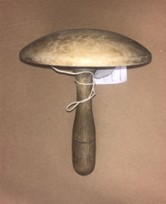Exploring Accessible Cooking Tools
Explore accessible cooking tools and cookery with our Curating Visibility Fellow, Anahita Harding
When I began working at the Food Museum, as part of the Curating Visibility Programme with Screen South, I wanted to explore how museum collections could tell the stories of disabled people. I’ve been looking at the intersection of disability, food, and the historical objects housed here, focusing on how they reflect both the challenges and innovations in accessibility.
So far I’ve been drawn to the kitchen tools in the collection. They tell a story of how food is prepared and cooked; for disabled people like me, cooking can be incredibly difficult for various reasons, such as spilling hot liquids, difficulties chopping vegetables, or carrying heavy pots.
As a full-time wheelchair user, I know some of the challenges that come with cooking from first hand experience. Simple tasks for a non-disabled person can become dangerous for me—like trying to lift a pot with one hand while pushing my wheelchair with the other, or reaching an oven that’s too high. These difficulties are why I’m so interested in accessible cooking. While some disabled people have carers or PAs (Personal Assistants) to help with cooking, many don’t, or face time limits on how long that assistance is available. This often leads to a reliance on quick meals like sandwiches or microwave meals, rather than fresh, nourishing dishes.
In my first few months exploring the museum collection, I’ve been drawn to historical kitchen tools and their connections to modern adaptations for disabled people, particularly in making food preparation more accessible. One highlight is a potato peeler and clamp from the 1930s, which, though not designed specifically for disabled people, would offer a great solution for some disabled people by allowing potatoes to be peeled with one hand.
The evolution of tools like the potato masher is also fascinating—my favourite is an 1898 mushroom-shaped masher that would have required significant effort to use. This contrasts with today’s electronic mashers, which make the task much easier for many disabled and older people. Even a 1920s bread knife, with its comfortable handle, hints at early efforts to reduce physical strain- today’s adaptive designs have refined this idea even further. These historical tools show how much current disability-friendly kitchen equipment owes to earlier innovations, whether intentional or not.

STMEA:A.7266; bread knife probably made in the 1920s

STMEA: 78.A.26; wooden potato masher, domestic use
I want to bring these historical tools to life by collaborating with disabled people from Stowmarket, for us to engage with these objects firsthand and compare them with their modern counterparts. Together, we’ll cook dishes using similar tools, creating a tactile experience that connects the past and present.
Do you have any stories about disability and accessing food? Feel free to get in touch at anahita.harding@foodmuseum.org.uk
Share this article



